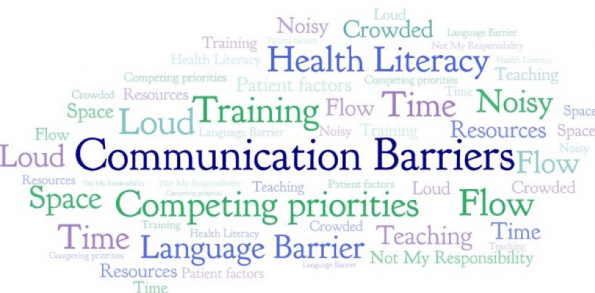During your medical training, how many times did someone watch you talk to a real patient? What about explaining their diagnosis? Or how to take their medications? Have you had a conversation with a patient and felt that you weren’t “speaking the same language”? Good physician communication with patients is linked to better outcomes for both patients and providers. But how do you become a good communicator? This post explains why talking to patients is important and reviews evidence based communication skills that can improve your everyday practice.
Why Communication is Important
For patients, good communication:
- Improves Patient Adherence
- Patients are unlikely to do something if they don’t understand why they need to do it
- Training physicians to communicate further improves patient adherence
- Patients are less likely to get complications of their disease and have an overall BETTER health status
- Lowers Health Care Utilization
- Leads to decreased ED visits and hospital admissions for patients with CHF, COPD, and diabetes
- Prevents Adverse Events
- Communication failure was the root cause for 64% of serious safety events reported to the Joint Commission from 2014-2015
For doctors, good communication skills are linked to:
- Fewer College Complaints and Lawsuits
- Studies of medicolegal cases have consistently shown a link between litigation rates and a physician’s communication skills
- Avoidance of Diagnostic Errors
- Part of a diagnostic error is the failure to explain the cause of a patient’s health problem to the patient
- Preventing diagnostic errors has been highlighted as a quality issue by the CMPA, National Academies Health and Medicine Division, and the WHO
- Lowering Burnout Symptoms
- Cleveland Clinic study followed physicians after a 1 day communication course and found burnout symptoms were significantly lower 3 months later

Barriers to Good Communication
- Inadequate Health Literacy
- Health literacy is a measure of a person’s ability to access, understand, and apply health information to make health decisions in their everyday life
- 60% of Canadians have INADEQUATE health literacy
- In Canadians over 65, that number increases to 88%
- Average health literacy in Canada is at a grade 5 reading level
- Canadian Public Health Agency found that physicians are unaware and unfamiliar with health literacy and its impact on patient outcomes
- Majority of our ED patients have difficulty understanding most of what we say
- Patient’s Don’t Realize What They Don’t Know
- Significant gaps exist between what patients think they understand and what they actually understand
- Men and patients with post-secondary education were more likely to overestimate their knowledge
- Physicians are Unaware of Their Communication Skills
- Tend to overestimate how well they can communicate
- In some cases, physicians adopt defensive behaviours
- Example – why didn’t your patient fill their prescription?
- Physicians likely to focus on patient factors (lazy, don’t care about their health) than consider their role (did they explain what the medication is for, why they need to take it, how to take it, etc.)
- 28% ED staff who were required to take a 2 hour communication course felt that it was “not worth my time” before they even took it; despite their disinterest, their communication scores significantly improved after the course
- System Factors
- Lack of appropriate resources
- Most online information is not written at appropriate level
- Creating adequate resources takes a significant amount of time
- Emergency department is not ideal for communication
- High work load, limited time, noisy space, other competing priorities
- Communication training is missing in most undergraduate and postgraduate medical training programs
- Lack of appropriate resources
Skills to Improve Communication
- Practice patient-centered communication
- Focus on getting the patient’s perspective of their unique situation to reach a shared understanding of their health (i.e. focus on the patient, not their illness)
- Active listening is a core concept for patient-centered communication
- Giving your full, undivided attention to the speaker and what they are saying
- This also includes your non-verbal behaviours
- Skills to Improve Your Active Listening
- Recap/Summarize your patient’s statements
- You already have these skills from leading resuscitations and sim cases
- Examples:
- “So, from what you have told me so far, you…”
- “Let me make sure I understand you…”
- Be mindful of your non-verbal behaviours
- Everything you do is considered a form of communication
- Try not to interrupt patients
- Sit down when possible
- Look at your patient (not at a screen!)
- Uncross your arms à it can be hard to figure out what to do with your arms, one option is the Angela Merkel power pose
- Use empathy
- One of the most effective communication tools physicians can use
- Acknowledge how patients feel; they do not expect you to fix whatever is causing them to feel that way (non-clinical example)
- Examples:
- “This has been hard on you”
- “Sounds like you’ve had a lot to deal with”
- Recap/Summarize your patient’s statements
- Use clear language to address low health literacy
- Evidence based method of presenting clear information so patients will understand it the first time they read, watch or hear it
- Clear Language Principles
- Do not use jargon
- Use strong verbs in short sentences
- Use conversational and active voice
- Avoid multi-syllabic and unnecessary words
- When you brush your dog, you get a big pile of fur, but all the important “points” of your dog are still there
- Same thing applies to what you say or write
- Example – back pain discharge instructions:
- Reading level – Grade 9.5
- You can take over the counter pain medication, like Tylenol or Advil, as needed.
- Make an appointment with your family doctor for reassessment of your pain within a week.
- Return to the emergency department if you develop a fever, the pain becomes severe, or you get weakness in your legs.
- Remove passive voice, simplify language à Reading level – Grade 4.6
- Take pain medication like Tylenol or Advil
- See your family doctor within a week, so they can help you with your pain
- Come back if the pain gets worse, you get a fever, or you can’t move your legs
- Reading level – Grade 9.5
- Provide information in multiple forms
- Other forms of communication include:
- Written handouts (online or locally made)
- Videos (also improve patient recall and these great resources already exist)
- However, these should NOT replace talking and explaining things to your patients
- Other forms of communication include:
- Verify patient understanding
- Think about how you tell patients to take medications
- In one study, patients were given a medication bottle, asked how to take it and then to show how they would take it
- 79% of patients with poor health literacy could read the directions, but only 51% take it properly
- ED studies have demonstrated that the teach-back technique can quickly verify patients’ understanding and improves information recall
- Ask the patient to state in their own words what they understood
- Simply repeating your words does not indicate understanding!
- It is not a test of their knowledge but of how well you explained things to them
- Examples:
- “So I know that I have explained this properly, can you tell me in your own words about….”
- “We talked about a lot of things today, I want to make sure everything I said was clear. Tell me what you will do at home if…”
- Ask the patient to state in their own words what they understood
- Think about how you tell patients to take medications
Putting It All Together
- In order to improve there are a few things to realize:
- It is challenging to change the way you talk to patients
- Applying these skills all the time is not realistic
- Start using one or two skills depending on the patient or the points you want to emphasize
- Written instructions for your elderly patients
- Sitting down when you can
- Teach-back for return to ED instructions for high risk chest pain patients
- Using empathy for chronic pain patients
- Over time these skills will weave their way into your everyday practice, and that is how you become a good communicator
Take Home Points
- What you say to patients matters to both you and the patient
- Practice active listening by using your recap skills and empathy
- Be aware of your body language
- Use clear language when talking with patients
- Provide written or video information whenever possible
- Ensure patients understand what you are saying with a teach-back
References
- Canadian Medical Protective Association. Physician-Patient Communication : Making It Better.; 2010.
- Association CMP. College Complaints on the Rise : Better Communication Can Help.; 2018.
- Aaronson EL, White BA, Black L, et al. Training to Improve Communication Quality: An Efficient Interdisciplinary Experience for Emergency Department Clinicians. Am J Med Qual. 2018. doi:10.1177/1062860618799936
- Ackermann S, Ghanim L, Heierle A, et al. Information structuring improves recall of emergency discharge information: a randomized clinical trial. Psychol Heal Med. 2017;22(6):646-662. doi:10.1080/13548506.2016.1198816
- Boissy A, Windover AK, Bokar D, et al. Communication Skills Training for Physicians Improves Patient Satisfaction. J Gen Intern Med. 2016;31(7):755-761. doi:10.1007/s11606-016-3597-2
- Caplin M, Saunders T. Utilizing teach-back to reinforce patient education: A step-by-step approach. Orthop Nurs. 2015;34(6):365-368. doi:10.1097/NOR.0000000000000197
- Cinar O, Ak M, Sutcigil L, et al. Communication skills training for emergency medicine residents. Eur J Emerg Med. 2012;19(1):9-13. doi:10.1097/MEJ.0b013e328346d56d
- Davis TC, Wolf MS, Bass PF, et al. Literacy and misunderstanding prescription drug labels. Ann Intern Med. 2006;145(12):887-894. doi:10.7326/0003-4819-145-12-200612190-00144
- Fossli Jensen B, Gulbrandsen P, Dahl FA, Krupat E, Frankel RM, Finset A. Effectiveness of a short course in clinical communication skills for hospital doctors: Results of a crossover randomized controlled trial (ISRCTN22153332). Patient Educ Couns. 2011;84(2):163-169. doi:10.1016/j.pec.2010.08.028
- Griffey RT, Shin N, Jones S, et al. The impact of teach-back on comprehension of discharge instructions and satisfaction among emergency patients with limited health literacy: A randomized, controlled study. J Commun Healthc. 2015;8(1):10-21. doi:10.1179/1753807615Y.0000000001
- Horwitz LI, Moriarty JP, Chen C, et al. Quality of discharge practices and patient understanding at an academic medical center. JAMA Intern Med. 2013;173(18):1715-1722. doi:10.1001/jamainternmed.2013.9318
- Houts PS, Doak CC, Doak LG, Loscalzo MJ. The role of pictures in improving health communication: A review of research on attention, comprehension, recall, and adherence. Patient Educ Couns. 2006;61(2):173-190. doi:10.1016/j.pec.2005.05.004
- Jawad Hashim M. Patient-centered communication: Basic skills. Am Fam Physician. 2017;95(1):29-34.
- Kee JWY, Khoo HS, Lim I, Koh MYH. Communication Skills in Patient-Doctor Interactions: Learning from Patient Complaints. Heal Prof Educ. 2018;4(2):97-106. doi:10.1016/j.hpe.2017.03.006
- Levinson W, Lesser CS, Epstein RM. Developing physician communication skills for patient-centered care. Health Aff. 2010;29(7):1310-1318. doi:10.1377/hlthaff.2009.0450
- Levinson W, Roter DL, John P, Dull VT. Physician-Patient Communication Relationship With Malpractice Claim. JAMA. 1997;277(7):553-559.
- Lin MJ, Tirosh AG, Landry A. Examining patient comprehension of emergency department discharge instructions: Who says they understand when they do not? Intern Emerg Med. 2015;10(8):993-1002. doi:10.1007/s11739-015-1311-8
- Merel SE, McKinney CM, Ufkes P, Kwan AC, White AA. Sitting at patients’ bedsides may improve patients’ perceptions of physician communication skills. J Hosp Med. 2016;11(12):865-868. doi:10.1002/jhm.2634
- Rootman I, Ronson B. Literacy and health research in Canada: Where have we been and where should we go? Can J Public Heal. 2005;96(SUPPL. 2). doi:10.1007/bf03403703
- Rost M, Wilson JJ. Active listening. Act List. 2013;34(12):1-338. doi:10.4324/9781315832920
- Samuels-Kalow M, Hardy E, Rhodes K, Mollen C. “Like a dialogue”: Teach-back in the emergency department. Patient Educ Couns. 2016;99(4):549-554. doi:10.1016/j.pec.2015.10.030
- Schwartzberg JG, Cowett A, VanGeest J, Wolf MS. Communication techniques for patients with low health literacy: A survey of physicians, nurses, and pharmacists. Am J Health Behav. 2007;31(SUPPL. 1):96-104. doi:10.5993/ajhb.31.s1.12
- Shukla AK, Yadav VS, Kastury N. Doctor-patient communication: An important but often ignored aspect in clinical medicine. Journal, Indian Acad Clin Med. 2010;11(3):208-211.
- Slater BA, Huang Y, Dalawari P. The Impact of Teach-Back Method on Retention of Key Domains of Emergency Department Discharge Instructions. J Emerg Med. 2017;53(5):e59-e65. doi:10.1016/j.jemermed.2017.06.032
- Stewart MA. Effective physician-patient communication and health outcomes: A review. Cmaj. 1995;152(9):1423-1433.
- Sustersic M, Tissot M, Tyrant J, et al. Impact of patient information leaflets on doctor-patient communication in the context of acute conditions: A prospective, controlled, before-after study in two French emergency departments. BMJ Open. 2019;9(2):1-10. doi:10.1136/bmjopen-2018-024184
- Swayden KJ, Anderson KK, Connelly LM, Moran JS, McMahon JK, Arnold PM. Effect of sitting vs. standing on perception of provider time at bedside: A pilot study. Patient Educ Couns. 2012;86(2):166-171. doi:10.1016/j.pec.2011.05.024
- Weger H, Castle Bell G, Minei EM, Robinson MC. The Relative Effectiveness of Active Listening in Initial Interactions. Int J List. 2014;28(1):13-31. doi:10.1080/10904018.2013.813234
- Weston WW, Brown JB, Stewart MA. Patient-centred interviewing part I: understanding patients’ experiences. Can Fam Physician. 1989;35:147-151. http://www.ncbi.nlm.nih.gov/pubmed/21253278%0Ahttp://www.pubmedcentral.nih.gov/articlerender.fcgi?artid=PMC2280441.
- Association CMP. Better Communication Can Help.; 2016.
- Altin SV, Finke I, Kautz-Freimuth S, Stock S. The evolution of health literacy assessment tools: A systematic review. BMC Public Health. 2014;14(1). doi:10.1186/1471-2458-14-1207
- Schwartz F. Health Literacy. In: Public Health Ontario Grand Rounds. ; 2018.
- Kates N. Health Literacy and its Effect on Health Outcomes. 2013;(Health Quality Transformation).




Trackbacks/Pingbacks